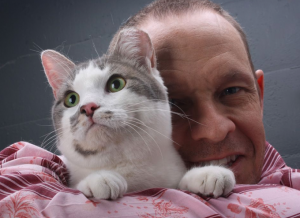
Peter with Smudge, who used to be part of a cat colony (the tipped ear is an indication that he was trapped, neutered and released).
Today’s Father’s Day edition of Cat Man Monday (on a Sunday!) is written by Peter Wolf. Peter’s been a cat guy since he can remember, describing himself as a “cat magnet” for neighborhood strays growing up. It’s no surprise he grew up to have cats of his own, but his cat connection goes beyond the ordinary.
Of them he says, “Cats have this uncanny ability to catch me with my guard down – to bring out a side of me I don’t see very often. How can I not admire—and be profoundly grateful for—that?” Well, he’s certainly returning the favor because Peter has made it his personal mission to educate the public on the importance of trap-neuter-return (TNR) programs and why not all cats are better of being “rescued” and placed into shelters.
• • •
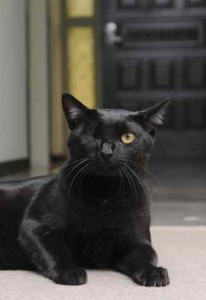
Sweet one-eyed Sebastian came to Best Friends by way of the Great Kitty Rescue. (photo: Tony Snow)
I certainly wasn’t “in the market” for another cat when I met Sebastian—timid and sweet, but also insistent that I sit right down in the dirt with him and have a proper visit. The intense, instantaneous connection he and I shared from the moment we met was unlike anything I’ve experienced. Being “chosen” like that was nothing short of magical—a moment I won’t forget anytime soon.
But the whole thing was more than a little unsettling, too. What exactly did this one-eyed black cat see in me?
A way home, for one thing. Sebastian was one of nearly 1,000 cats rescued by Best Friends Animal Society following the 2007 collapse of a Nevada cat sanctuary—described by the local paper as a “shelter-turned-death-camp.” This enormous undertaking, which drew numerous volunteers from across the country, came to be known as the Great Kitty Rescue (GKR).
By the time I met Sebastian, the vast majority of GKR cats had been adopted; he’d been “in the system” for more than a year. And so, despite my reluctance to disrupt a remarkably harmonious three-cat household by introducing a fourth, I adopted Sebastian.
Less than three months later, I adopted Ginseng, another GKR cat. If my bond with Sebastian was immediate and obvious, my connection with Ginseng was decidedly less direct. Indeed, she’s kept me guessing for nearly four years now.
• • •
The Great Kitty Rescue was a life-changing event for so many. For hundreds of cats, obviously, but also for the people involved. In my case, that meant no longer being satisfied to sit quietly on the sidelines—volunteering here and there, and writing the occasional check. Not that there’s anything wrong with that, of course, but I felt compelled to do more.
But what could I do?
The answer revealed itself as I began telling the GKR story, and discovered a much bigger one: the plight this country’s stray, abandoned, and feral cats.
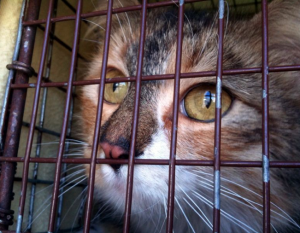
This young lady was trapped as part of a TNR program but turned out to be so social she was adopted!
Because many of these cats lack the social skills that would make them easy adoption candidates, the greatest risk they face is not life on the streets, but, more often than not, the animal control system. In his book Redemption: The Myth of Pet Overpopulation and the No Kill Revolution in America, Nathan Winograd, Director of the No Kill Advocacy Center, observes: “there is no other animal entering a shelter whose prospects are so grim and outcome so certain.”
The best way to improve the lives of “community cats,” as they’re sometimes called, is through trap-neuter-return (TNR), an approach to managing their numbers through sterilization. Although TNR has been used in Britain since the 1950s, its adoption in the U.S. is a more recent phenomenon. Alley Cat Allies, the first national organization to focus on TNR, was founded just 22 years ago. These days, TNR is common practice, and has
been made official policy in numerous communities across the country.
Not everybody is on board, however. In fact, there’s been a concerted effort for nearly 20 years now to develop policies, at both the local and federal levels, that would greatly restrict TNR—if not outlaw it entirely. Even the feeding of outdoor cats would be prohibited. It’s an agenda aided by a growing body of flawed science (some of which borders on outright fraud) “sold,” in easy sound bites, to the mainstream media, and, in turn, the public.
In the past couple of years, though, such messaging has gotten a bit more difficult. In April 2010, I launched Vox Felina (meaning “voice of the cats”), a blog where I untangle the science and policy issues surrounding TNR, providing advocates the resources they need to challenge, point-by-point, the bogus claims made by those who would just as soon round-up every last “homeless” cat.
Over the past couple of years, the blog’s attracted a devoted audience of feral cat advocates and become an invaluable resource for journalists, including writers from Animal People, Conservation magazine, the San Francisco Chronicle, and The Washingtonian.
• • •
Having more cats than I could count on one hand was never something I aspired to, but my decision to adopt Sebastian and Ginseng is one I’ll never regret. Whatever I might provide for them pales in comparison to what they’ve already brought me. Through them—and, more broadly, the Great Kitty Rescue—I’ve found my life’s work.
By giving a voice to our stray, abandoned, and feral cats, it seems I’m finding my own.
– Peter Wolf
Now go vote for Peter in the Stray Cat Alliance’s Cat Daddy Contest for Father’s Day!

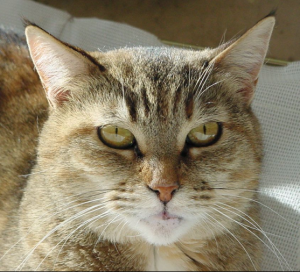
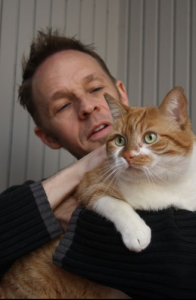
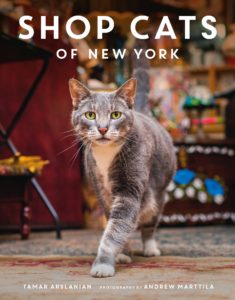




16 Responses to Cat Man Monday: Father’s Day Edition